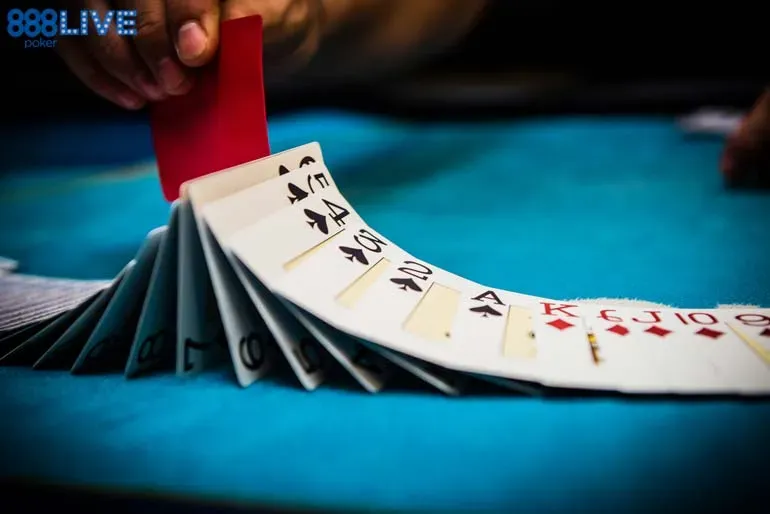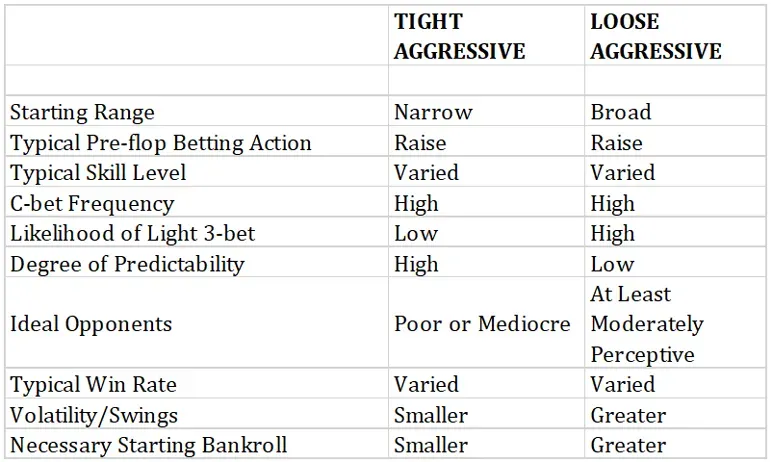Poker players may be divided into different categories of playing styles.
The most prominent of these is undoubtedly the Tight-Aggressive Player – or “TAG” for short.
In this article, we’ll examine:
- Precisely what a tight-aggressive player is,
- How you can spot them.
- The starting hands that he typically plays.
- How he differs from a loose-aggressive player (LAG)
- How you can exploit him.
Defining Tight-Aggressive
Simply put, a tight-aggressive player is one who tends to play very few starting hands. When he elects to play a hand, he generally plays it aggressively. He does not like to call with his strong hands – but rather bets or raises to drive out opponents or make them pay a steep cost to see future cards.
This style of play differs from that of a “rock” or “nit”, who tends to play an even narrower range pre-flop (especially from late position), and who lacks the aggression of a typical tight-aggressive player.
Identifying Tight-Aggressive Players
The simplest and most accurate method of identifying a tight-aggressive player is to watch how many hands he plays and how aggressively he plays them. If, after a couple of orbits, an opponent has played only 15-20% of hands, typically with a raise or 3-bet, you are almost surely dealing with a tight-aggressive player.
You can confirm this diagnosis by making sure to observe any hands that are shown down or otherwise exposed. If a large percentage of them are high-quality starting hands, you can conclude that your suspicions were correct.
You may also be able to accurately identify tight-aggressive opponents even without waiting for a full two orbits. There are other “secondary characteristics” that typical tight-aggressive players display. They tend to keep their chips in even stacks of 20 – sometimes even with the stripes on the side of the chips lined up.
Their physical betting of the chips is crisp and neat. They are often very attentive, serious, and earnest in their demeanour. This is not to say that loose-aggressive players or other types of players can’t affect this behaviour as well. It’s just that tight-aggressive players usually behave in this way most of all.
Finally, be aware that the most skilled players may change their style (known as “changing gears”) just as you think you have them figured out. So be ready to alter your assessment, even after you have confirmed it.
Tight-Aggressive Player’s Range
A tight-aggressive player’s range will change depending on his position, of course. Specifically, a tight-aggressive player’s range in early position may be no broader than QQ+ (QQ, KK, AA) and AK. In middle-position, he may widen that range to include TT+, ATs+, KQs, QJs, and JTs. In late position, he might broaden it further to include AT+, A2s+, KQs, KJs, QJ, and all 22+.
Recognise that there are all sorts of variations in the range any particular player may have – including these tight-aggressive players. There are degrees of tightness and degrees of aggressiveness. Similarly, these ranges are not necessarily static – as players may become tighter or looser as their mood, game conditions, and their opponents change.
They may have some calling range – but it tends to be much narrower than a player who is not tight-aggressive. Typically, this TAG player is raising with his entire range in early and middle position, and only calling in late position with his pairs 22-88, and his suited aces A2-A9.
Tight-aggressive players are also ready to 3-bet in many situations when their hand strength justifies it. So, for example, their 3-bet range would be likely to include KK, AA and maybe AK and QQ from early position; JJ+ and AK from middle position, and TT, AK, and AJs+ from late position. Keep in mind that individual TAGs may each play a broader or narrower range than these.
It’s important to realise that the TAG playing style does not exclude the possibility of including a broader raising range, a broader 3-bet range, and even a reasonable number of bluffing hands. Good tight-aggressive players may adjust their range to fit the general conditions of their table, their own image, and their specific opponents – just as any good player would.
It’s just that the range is generally tighter than most of the other players at the table, and they tend to play their hands more aggressively than the typical player.
Tight Aggressive (TAG) Vs Loose Aggressive (LAG)
A loose-aggressive (LAG) player is much more likely to play a much broader range than the tight-aggressive player and to play it aggressively. This strategy includes raising and 3-betting light. A tight-aggressive player is much more likely to have higher standards than the LAG for raising and 3-betting.
One straightforward way of understanding this is to look at the TAG player’s range from late position. It includes many sub-premium hands like suited Aces and other non-pair hands. The loose-aggressive player might play this range from any position pre-flop – and will play it for a raise, or for a 3-bet.
Strengths and Weaknesses of Tight-Aggressive Play
There is nothing inherently strong or weak about the tight-aggressive style of play – or any style of play for that matter. All methods of play may be used by an expert to win money from the non-expert. Weak players will lose no matter what style they adopt. In that respect, no one style is clearly or definitely better than any other. Great players utilising a tight-aggressive style can win a lot of money from mediocre opponents. But, so too can loose-aggressive players win a lot of money from mediocre opponents.
- Changing Gears
The key is recognising the strengths and weakness of each style – changing gears (going from one form of play to another) just as your opponents are figuring it out. Then, when they start to shift their play to adjust for the type of player, they think you are, you should move on to a different style. When they finally catch on to this switch, you switch again – ad infinitum until you have turned them in a quivering mush of self-doubt. They end up leaving your table with their spirit and finances crushed. - Predictability
Tight-aggressive play tends to be more predictable than loose-aggressive style – since the narrower pre-flop range restricts the likely range as the hand develops. Since the TAG’s starting range is much more restricted, perceptive opponents will be better able to put a tight-aggressive player on a very narrow. This scenario is less the case with a LAG. He starts with a much broader range. Therefore, it is often unclear whether a flop, turn, or river helped his hand. - Lower Variance
One advantage of a tight-aggressive player over a loose-aggressive player is that tight aggressive play is less costly than loose-aggressive play, with lower variance. Since the TAG is playing many fewer hands than the LAG, he is spending much less money on speculative hands. With fewer hands, in a stronger range than his LAG counterparts, he will have less variance. Accordingly, he can fund his play with a smaller starting bankroll.
- Aggressive Betting
Against inferior opponents, who do not pay much attention to their opponents’ style, and thereby fail to shift their play accordingly, the tight-aggressive style has many advantages. This type of player will win money from his opponents when he aggressively bets his higher quality hands, but will not lose or waste money by being aggressive on his lower-valued hands. He doesn’t need to play as wide a range because his weak opponents will not be observant enough or disciplined enough to avoid him when he is selectively aggressive.
On the other hand, by being more predictable, his observant and skillful opponents will learn to avoid him when he is aggressive, diminishing his likely wins when he does win. So, though his losses will likely be less, so too will his potential wins.
Overall, whether the TAG does better than the LAG will be a function of how good an overall player he is and how bad his opposition is. There is nothing inherent in the style of play that dictates whether the TAG will win or lose more in the long run than the LAG.
Techniques for Exploiting Tight-Aggressive Players
Once you have identified a tight-aggressive player, you will be able to attempt to exploit him. Your ability to do so will depend, at least in part, on how good he is – and how capable he is to adjust his play once he notices your attempts to exploit him.
But assuming he is no better than average, here are some techniques that are likely to work:
Aggression = Strength
First, recognise that his aggression generally indicates true strength. So, when he bets or raises, refuse to give him action unless you have a hand that is either already strong or has good drawing potential. If he is extremely tight, you may do best by not playing against him at all.
He will be in so few hands, that you needn’t worry about your ability to make money off the other players at your table. Just resolve to fold your hand on the rare occasion when he bets – and wait for the next hand, which he is unlikely to enter because he doesn’t have Aces or Kings.
Speculate Against the Sticky TAGs
Against other tight-aggressive players, who have at least a reasonably broad range – especially from late position – you can use a few “moves” against them to extract some profit. Realise that tight-aggressive players tend to continue to push their hands aggressively through the flop and turn – even when others may improve.
Accordingly, with their rare AA, KK, or QQ from early position, they will continue to bet it unimproved, in increasing amounts each bet – wanting to extract maximum profit from the narrow range they play.

They aren’t liable to return fire as a loose-aggressive player – since they play so few hands. They tend to be quite “sticky” when they have one of their few playable hands – not wanting to give. Against these tight-aggressive players, you can call their pre-flop raises with many speculative hands. If you miss, you’ll fold to their bet on the flop. But if you hit, you’ll let them bet themselves into penury against your two pair, sets, and flushes.
Position becomes extremely important, as you want to see his betting action before you enter a hand against them. Their betting will be a window into the real strength of their hand, given their ABC-style of tight-aggressive play. You can play against them as if they are playing with their cards exposed.
Example of Exploiting a Typical TAG
Here’s an example of how that exploitive play against a typical tight-aggressive player may work. (Bear in mind that I am not recommending this against a solid player – but rather against an average, mediocre or worse tight-aggressive player.)
Pre-flop you are in the cutoff seat in a $1/2 game with a $500 effective stack against the eventual Villain who is a typical, tight-aggressive player.
UTG folds
UTG+1 calls $2
UTG+2 folds
UTG+3 folds
Villain is in the lo-jack position. He raises to $15.
Everyone folds to you. You have Qh Th.
If he were an extremely tight TAG, you might just fold – figuring that you needn’t bother fighting it out with him. Folding is undoubtedly a reasonable and safe option against a particularly tight TAG. You’d remember the mantra “don’t feed the nit” and just wait for another hand.
But, assuming he’s not quite as tight as all that, you can call here – even though you know that you are far behind. You can call because $15 is only 3% of your stack – giving you enormous implied odds if you hit your hand of two pair, trips, a flush, or a straight.
As a typical tight-aggressive player, he’s likely to keep betting, in ever-increasing amounts. So, you call his bet on the flop, and then either raise him on the turn or wait for him to donk off his chips to you on the river.
Using the Bluff, Selectively
The other move that may work against some of the better tight-aggressive players is to selectively raise them on the flop as a bluff – to get them to release their hand, fearing that they are now second best.
Being selective, some good tight-aggressive players are still mindful of the possibility that the flop may occasionally give their opponent a very strong hand – surpassing their likely premium pair.
If, for example, they raise pre-flop, and you call, and then an Ace flops. They bet, and you uncharacteristically raise, they may figure that since this so seldom happens to them, they are better off not chancing that you hit Aces-Up or, worse, a set. They are then likely to fold, congratulating themselves at their excellent laydown (they may even show it to you).
Sometimes they will call your raise on the flop, hoping for a perfect turn, and you have to fire another bet on the turn for them to fold. Again, used very selectively, this is often an effective move against the reasonably good (but not great) tight-aggressive opponent.
Comparing Tight-Aggressive Player (TAG) to Loose-Aggressive Player (LAG)

In Conclusion
Poker games are populated by all sorts of players with many different playing styles. You will want to be able to identify just what type of player you’re up against, so you can apply the correct tactics to exploit them.
Fortunately, tight-aggressive players are relatively easy to spot. If they are very skilled, you should avoid them altogether. If not, you can make money off them by applying some of the tactics we’ve explored in this article.


